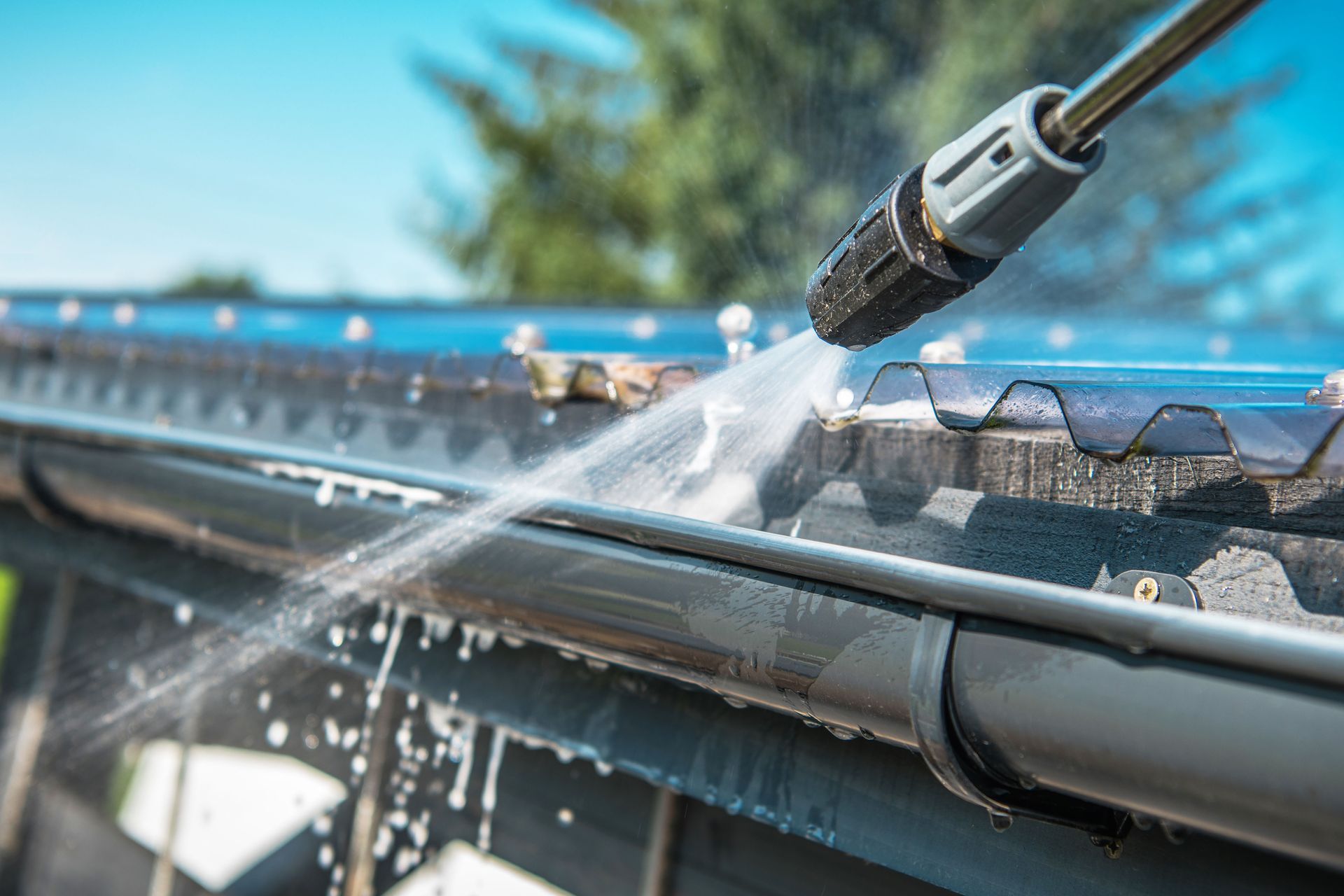October 29, 2025
Gutters play a critical role in protecting a home’s structural integrity by directing rainwater away from roofs, walls, and foundations. Without them, water can accumulate near a house's base, causing dampness, foundation erosion, and potential flooding. Homeowners investing in quality gutters prevent costly repairs and maintain property value. Water damage is among the leading causes of structural issues, and an effective gutter system serves as the first line of defense. Beyond foundation protection, gutters reduce mold growth, prevent soil erosion around landscaping, and safeguard exterior finishes. According to Forbes, 5-inch K-style gutters typically use 2-by-3-inch or 3×4-inch rectangular downspouts to manage water effectively. By carefully choosing gutters suited to their home's size and environment, homeowners can minimize long-term maintenance costs while ensuring optimal water flow.
Material Options for Gutters
Selecting the right material for gutters affects durability, maintenance, and overall aesthetics. Aluminum gutters are lightweight, rust-resistant, and easy to install, making them cost-effective for many homeowners. Copper gutters, though more expensive, provide long-term durability and develop a natural patina that enhances architectural appeal. Steel options, both galvanized and stainless, withstand high water volumes and heavy snow loads, though galvanized versions require more upkeep to prevent rust. Vinyl gutters are budget-friendly and simple to install but can crack in extreme weather conditions. Comparing longevity and maintenance needs helps homeowners align performance with aesthetic goals, ensuring that gutters remain both functional and visually appealing over time.
Steel gutters, particularly stainless steel, offer exceptional strength and resistance to corrosion, making them ideal for regions with heavy rainfall or snow. While initially more expensive than aluminum or vinyl, their durability often translates to lower long-term maintenance costs. Galvanized steel, though less costly, may require periodic inspections and protective coatings to prevent rust, especially in humid or coastal environments. For homeowners prioritizing resilience and longevity, steel gutters provide a reliable solution that can handle high volumes of water while maintaining structural integrity over decades.
Vinyl gutters, on the other hand, offer a lightweight and affordable option that is easy to install, particularly for DIY projects. They require minimal maintenance in mild climates and are resistant to rust, making them appealing for budget-conscious homeowners. However, vinyl can become brittle in extreme temperatures, leading to cracks or warping over time. For this reason, vinyl gutters are best suited to moderate climates where severe weather is infrequent. Understanding the strengths and limitations of each material helps homeowners make informed choices that balance cost, aesthetics, and long-term performance.
Styles and Shapes of Gutters
Gutter style influences both water management efficiency and curb appeal. K-style gutters offer a modern look with a flat bottom and decorative front, holding more water than half-round options. Half-round gutters provide a traditional aesthetic, commonly seen in historic homes, and are easier to clean, though they hold less water. Box gutters, integrated into the roofline, offer high capacity and a discreet appearance, often suited for upscale or commercial properties. Fascia gutters combine the function of fascia boards and seamless gutters for a sleek, minimalist look. Choosing a style that complements architectural design ensures gutters serve both functional and decorative purposes, integrating smoothly with the home’s overall aesthetic.
Selecting the right gutter style also affects maintenance requirements and long-term functionality. K-style gutters, with their angular design, may accumulate debris in the corners more easily than half-round gutters, requiring regular cleaning to prevent clogs. Half-round gutters, with smooth, curved interiors, facilitate easier debris flow and are less prone to blockages. Box gutters, though capable of handling large water volumes, often require precise installation and periodic inspections to prevent leaks, especially where rooflines are complex. Fascia gutters, while visually seamless, demand professional installation to ensure proper slope and water flow, minimizing the risk of standing water and overflow issues.
Understanding the maintenance implications of each style allows homeowners to select a gutter system that balances efficiency with convenience.
Beyond functionality, gutter style contributes significantly to a home’s visual appeal. K-style gutters complement contemporary architecture with their clean, angular lines, while half-round gutters enhance the charm of classic or historic homes. Box gutters provide a hidden, integrated look, ideal for preserving a refined exterior aesthetic, whereas fascia gutters offer a modern, minimalist finish that aligns with sleek architectural designs. Matching gutter style with the home’s overall design ensures that the system not only performs effectively but also enhances curb appeal.
A thoughtfully chosen gutter style can transform a purely functional component into a complementary architectural feature, creating a cohesive and polished exterior appearance.
Gutter Sizing and Capacity Considerations
Proper sizing is essential to prevent overflow and foundation damage. Undersized gutters may fail during heavy rainfall, while oversized systems can look disproportionate and unnecessarily increase costs. Determining the correct size involves measuring roof area, considering pitch, and accounting for local rainfall intensity. Downspout placement is equally critical, with strategic positioning at corners and junctions enhancing efficiency. For homes with irregular roof shapes or unique architectural features, customized gutter solutions optimize performance and maintain visual harmony, ensuring effective water management even in challenging designs.
Installation Options and Their Implications
Gutter installation can be approached through professional services or DIY efforts, depending on complexity, budget, and expertise. Professionals ensure secure attachment, proper pitch, and alignment, reducing the risk of leaks and overflow. DIY installation saves money but may lead to functional issues if improper techniques are used. Attachment methods—hidden hangers, brackets, or straps—affect both appearance and durability. Seamless gutters, custom-cut on-site, minimize leaks and provide a sleek finish, while sectional gutters offer cost-effective installation but require more maintenance at the joints. Understanding installation choices ensures gutters function optimally, with costs balanced against long-term performance and maintenance requirements.
Maintenance and Longevity of Your Gutter System
Routine inspection and cleaning are critical for extending the lifespan of gutters. Removing debris such as leaves and twigs, ideally twice per year, prevents clogging and overflow issues. Proper maintenance includes repairing leaks, adjusting sagging sections, and treating rust-prone areas, particularly for metal gutters. Gutter guards can further reduce maintenance needs by preventing debris accumulation and prolonging system life. Choosing quality materials and professional installation also enhances longevity. Proactive care ensures gutters continue to manage water effectively, protecting the home’s structural integrity and avoiding costly repairs over time.
Long-Term Benefits and Choosing the Right Gutters
Investing in well-designed gutters provides long-term protection, adds to curb appeal, and can increase property value. Efficient systems reduce maintenance, safeguard foundations, and preserve exterior finishes, minimizing future expenses. Selecting gutters suited to local climate conditions, roof design, and aesthetic preferences ensures both functionality and visual appeal. According to Forbes, properly sized and installed gutters can significantly reduce water-related home damage. By taking a thoughtful approach to material, style, sizing, and installation, homeowners achieve a durable, attractive system that protects their investment for years. Choosing the right gutters is a critical step in safeguarding a home from water damage while enhancing its curb appeal. From selecting materials like aluminum or copper to deciding between K-style or half-round shapes, every choice influences both performance and aesthetics. Proper sizing, professional installation, and ongoing maintenance ensure gutters remain effective for the long term. For homeowners seeking quality and expert guidance, Waters Way Gutters offers professional installation, durable materials, and tailored solutions to protect your home. According to industry standards, well-chosen gutters prevent costly structural damage and preserve property value, making them a vital investment for any residence. Contact Waters Way Gutters today to ensure your home is fully protected from the elements.

